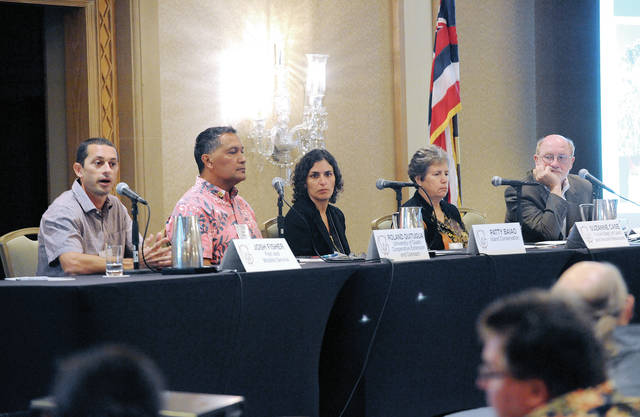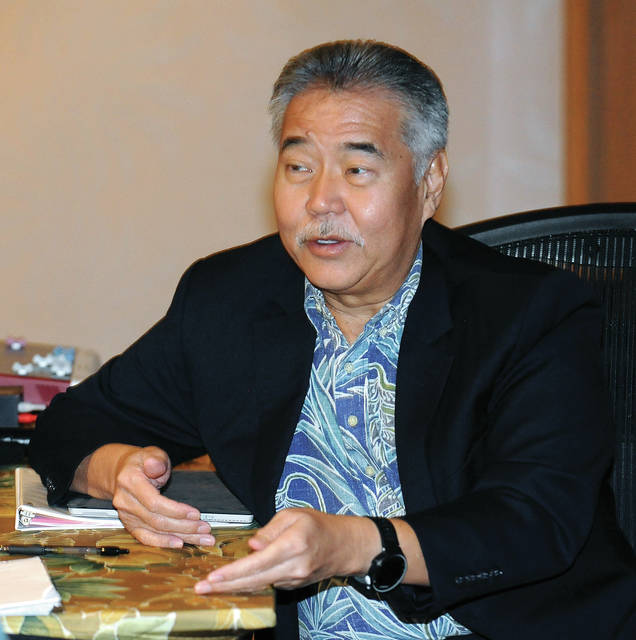KOHALA COAST — Biology may be only seven letters long, but it’s a big word in Hawaii.
A contingent of governors from 19 states and three U.S. territories convened at the Fairmont Orchid Monday on the first day of the Western Governors Association Winter Meeting. The topic of note was biosecurity, an initiative for which Hawaii has considerable ambitions.
Among them is a $35 million Pacific regional biocontrol facility, for which the Hawaii Department of Agriculture is holding $175,000 in scoping funds in the hopes of leveraging federal backing for the project.
Hawaii has two biocontrol facilities for insect research and one for work with diseases, the latter of which has lost its approval for containment. The state has also scaled back its biocontrol personnel in recent years from 12 research positions to only four.
Biocontrol, the practice of introducing a non-native predator to deal with an invasive species, is the preference of Gov. David Ige who wants to move away from man-made containments, typically chemicals, to wrangle pests both in the agriculture industry and generally across the state.
There are some in the scientific community apprehensive about biocontrols, as even with intensive study, it is possible introducing a new species into an environment will produce unpredictable effects.
“It’s about weighing the risk and reward,” Ige said. “The question is what is the damage done by the invasive, and can we manage the risk of a biocontrol agent to see that the reward and effectiveness of the agent far exceeds the damage done by the invasive species?”
Rob Curtiss, an entomologist who formerly worked in the HDOA biocontrol branch, said there’s little reason for concern under currently employed methods.
“I actually think the way that it’s done now, there are very few risks,” he said.
The predator is imported to a biocontrol facility where it is tested, sometimes for years. Curtiss used the example of a caterpillar thought to be useful in the control of a non-native weed.
Scientists will determine a suitable candidate from the weed’s geographical point of origin, then test to see if it poses a threat of consuming vegetation of economic, aesthetic or cultural importance.
Once cleared, a report is sent to the Hawaii Board of Agriculture. If the board agrees the species is safe for release, a federal process complete with a comment period is initiated.
“Because it’s very well known what they will and will not feed on, (scientists) have a really good idea of what will happen once they’re in the environment,” Curtiss said.
As the invasive species dwindles, so does the predator. Although, Curtiss pointed out that neither will ever disappear entirely because the species won’t eat itself into starvation. Biocontrol is about just that — control at a tolerable level.
Biocontrol has existed in some form in Hawaii since the 1890s, he added. But the process wasn’t always so sophisticated and the program made some mistakes.
While it wasn’t scientists or government officials responsible for their introduction, cattlemen brought over mongoose to deal with the troublesome rat population. Rats are nocturnal while mongoose aren’t, so the two rarely interact and both proliferated.
Curtiss said that example serves as a testament to the science existing behind the process now. Ige added that Hawaii has had past successes, introducing moths and other agents to control toxic weeds and fruit flies that did damage to the state’s $700 million-per-year agriculture industry.
Ige said mosquitoes would be an early target of the new facility due to their role as vectors in the spread of disease.
Dollars
Money dictates priority when it comes to invasive species, and while the state allocates and guarantees more now than it has in years, there’s never enough to go around.
Suzanne Case, chair of the Department of Land and Natural Resources, said there is $4 million in her baseline budget earmarked for invasive species concerns, but usually $10-12 million worth of important projects on the table. That, she said, leads to “painful decisions.”
However, Ige explained state agencies can and often do reach out to the Legislature for extra allocations when the needs arise. One specific example of that is rapid ohia death, which has ravaged the trees on Hawaii Island and has now been identified on Kauai.
“We are investing a lot in little red fire ants and rapid ohia death to allow us to put in place better containment strategies,” said Ige, adding it’s a balancing act to split the money the state has at its disposal between control of dangers already present and prevention of what may come.
Of 147 actions outlined in Hawaii’s interagency biosecurity plan first released last year, 24 percent are complete and 22 percent are underway. As of 2018, the state spends $57 million annually to fund biosecurity efforts. Implementation of the entire plan would add nearly $38 million more each year to the tab — equalling a total representing 0.7 percent of Hawaii’s overall budget.
One of the toughest challenges is simply manpower. The governor said “for the first time in a long time,” all the inspector positions are actually staffed. Yet current staffing numbers don’t come close to matching what would be required to check all cargo flowing into Hawaii.
“We know that the manpower that we have can only inspect 1-5 percent of the containers,” Ige explained. “Can we be smarter about selecting the containers that would be of highest risk and really focus the resources on that?”
Making smarter decisions, he continued, would be easier if the Legislature agrees to create an invasive species authority, an agency under which biosecurity responsibilities would be consolidated. Such a bill was introduced last session, but fell short of becoming law.
WGA
Ige described biosecurity as a “team sport,” adding a partnership with the federal government defined by common goals is crucial to success.
Over the last two years under the Trump administration, the federal government has sought to roll back environmental protections in several areas.
But Ige, who chairs the Western Governors Association, believes the WGA has been more successful working with the federal government than other groups and applies the optimal strategy of states/territories coming to the table as a contingent rather than going it alone.
“The opportunity we present to federal agencies is we are a bipartisan organization,” Ige said. “We really look at common goals and objectives that Democrats and Republicans can agree on, and that we can work in a bipartisan fashion.”
“It is an avenue for the (presidential) administration to find success, if it chooses to.”


